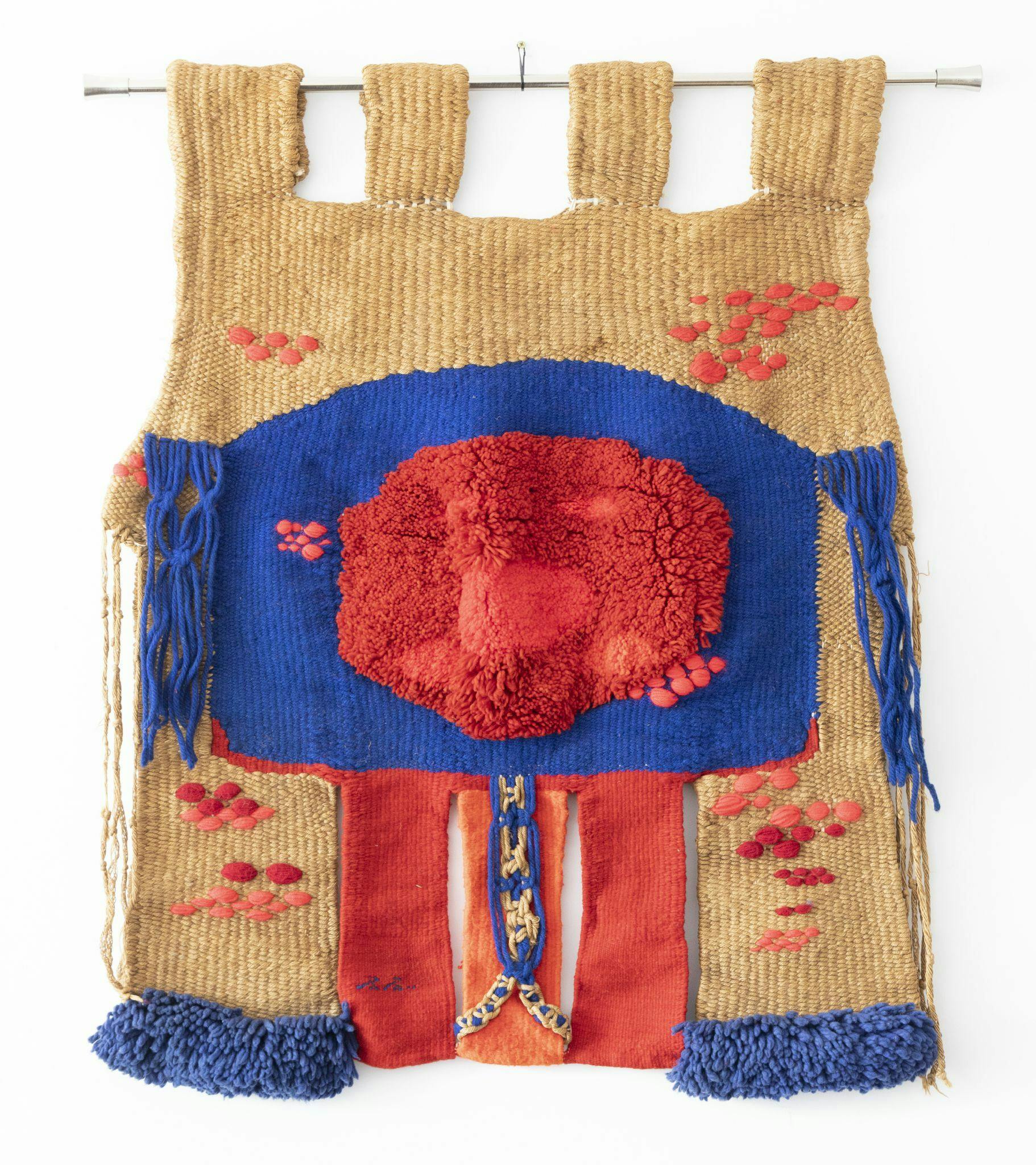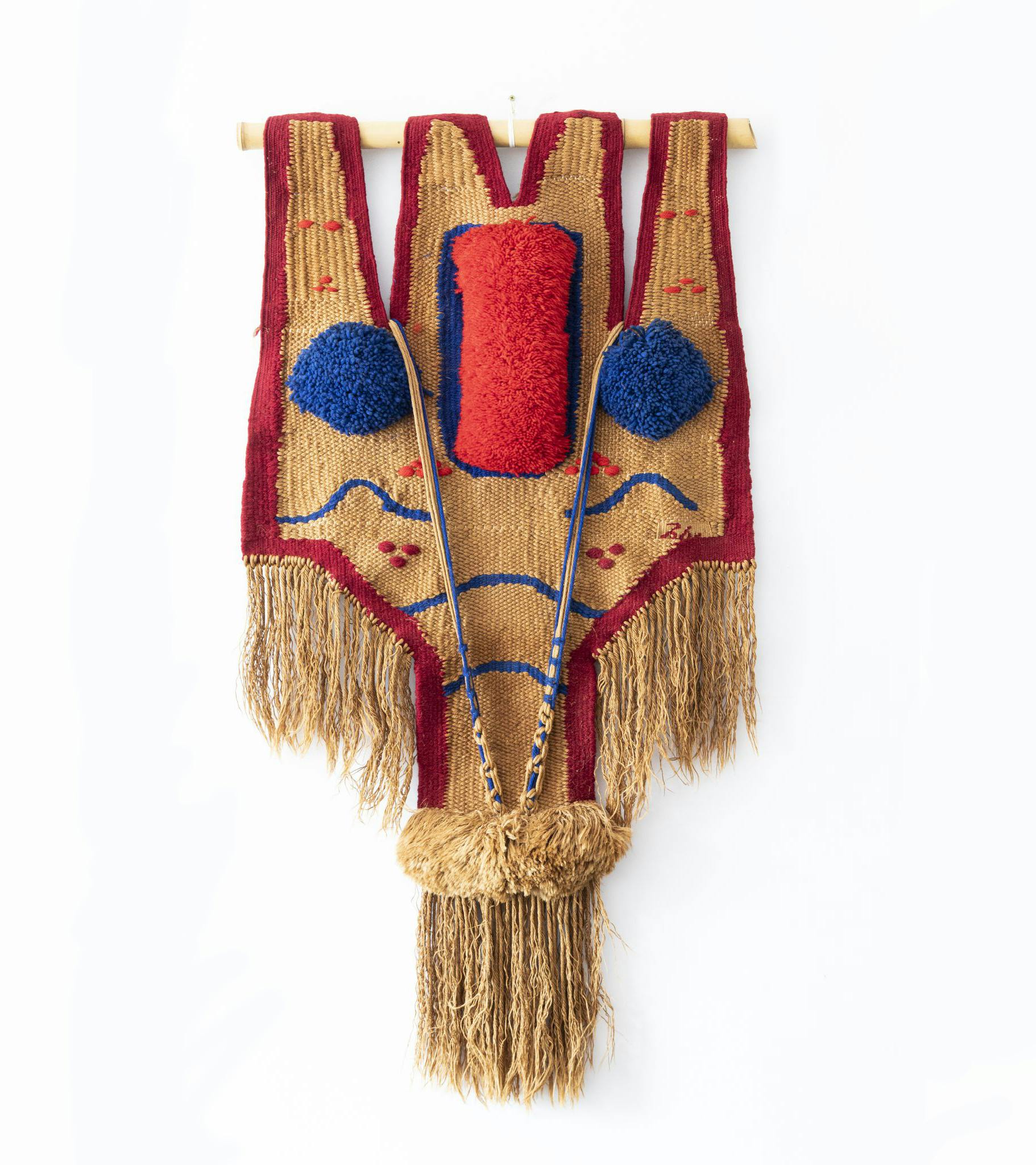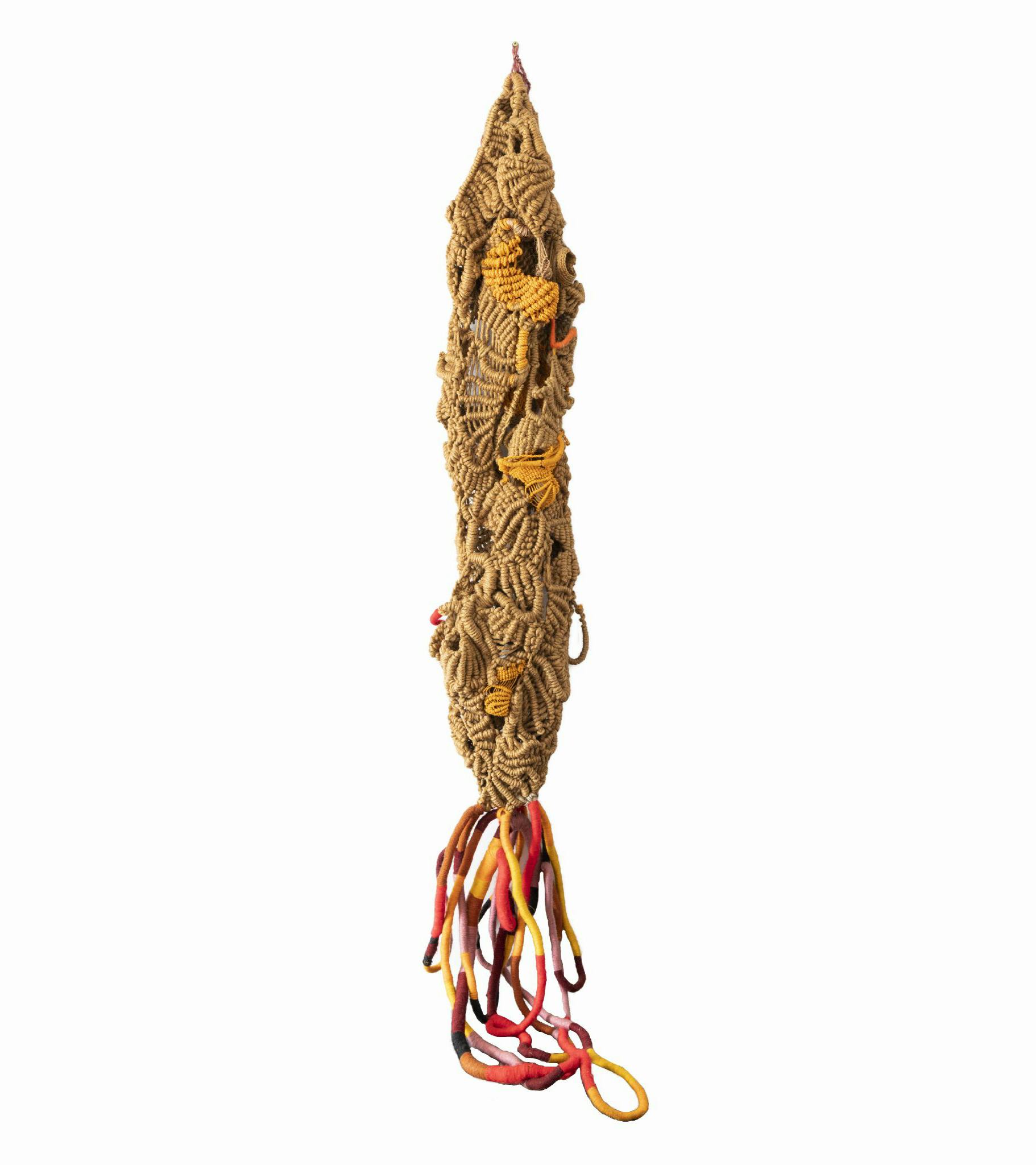Marta Palau, Amor nuevo, 1972. Wool and jute, 44 7/8 × 39 1/4 in. (113.9 × 99.7 cm). © the artist. Photo: Arturo Sánchez

Marta Palau, Amor nuevo, 1972. Wool and jute, 44 7/8 × 39 1/4 in. (113.9 × 99.7 cm). © the artist. Photo: Arturo Sánchez
Re: Collection invites a range of historians, curators, and artists to respond to the artworks in our collection through approachable texts.
Spanish-born Mexican sculptor Marta Palau was celebrated for her feminist and conceptual reclamation of techniques oft-dismissed as women’s work. In memory of the artist, who passed away in August 2022, curator Anna Burckhardt reflects on Palau’s artistic development and the symbolic and spiritual significance of her materials.

Marta Palau, Dharma, 1972. Wool and jute, 59 × 33 in. (149.9 × 83.8 cm). © the artist. Photo: Arturo Sánchez

Marta Palau, Untitled, 1970. Wool and jute, 85 × 12 1/2 in. (215.9 × 31.8 cm). © the artist. Photo: Arturo Sánchez
Marta Palau’s expansive body of work—like the sacred maguey plants that produce some of her most cherished fibers—is firmly rooted in Mexico. Her commitment to the material culture of her adoptive country informed her long-standing devotion to the relationship between what grows from the earth and spirituality. This particular, perhaps mythical, approach to regional materials also paradoxically spared her from comparisons to her generation’s so-called “fiber artists,” a term that has often been used by art historians since the 1960s to designate the work of mostly women artists who engage with textiles in various forms. 1
Born in Spain in 1939, Palau emigrated to Tijuana with her family in 1940 after the dissolution of the Second Spanish Republic and General Francisco Franco’s rise to power. She studied painting and sculpture at the Escuela Nacional de Pintura, Escultura y Grabado “La Esmeralda” in Mexico City before returning to Spain in the late 1960s, determined to learn about textiles from Josep Grau-Garriga. She had developed an interest in fiber and tapestry prior to her cross-continental move, experimenting with sarapes, rectangular wool blankets woven by hand or by machine in a variety of colors and motifs, and traditionally worn by men in Mexico. A design typology that comprises many different variations and materials and is not limited to a specific weaving technique, sarapes might have proven too ambiguous for Palau—their materiality too detached from their context and their construction too simple. 2 By contrast, Grau-Garriga’s practice strove to highlight the inherent meaning and expressive quality of materials, often mixing wool with humble fibers such as jute or hemp and interweaving plastic cords and pieces of used clothing to create distinctive textures. Grau-Garriga was inspired by traditional tapestries—especially the medieval ones seen in the churches of his native Catalonia—but he questioned the established approaches to weaving, seeking to expand on what he believed to be the overly rigid interplay of warp and weft in traditional loom weaving. He experimented with the three-dimensional possibilities of tapestry, creating textural wall hangings that are often characterized as sculptural.
Palau took up this mantle, fully embracing textiles and fiber without the constraints of the loom. 3 Like Grau, she removed tapestry from the wall, experimented with materials, and heightened the sculptural and architectural capabilities of the medium. It is worth noting that this sculptural treatment was also employed by other women artists such as Sheila Hicks and Magdalena Abakanowicz, whose practices, unlike those of Grau and Palau, have frequently been analyzed through the marginalizing lens of “craft.” Upon her return to Mexico, Palau united these formal concerns with artisanal practices from Tijuana like palm weaving and basketry, incorporating humble local materials such as plant fibers. In contrast to Hicks, whose own interest in the textile traditions of Mexico stemmed from their technical sophistication and was particularly drawn to the backstrap loom, 4 Palau’s work has been called “anti-technological” by art critic Rita Eder. “Her impatience with technical rules gives her work an electric quality, a sensation of immediacy that excludes preconceived feelings,” she has written. 5 The artist intuitively knotted, tied, cut, embroidered, and stitched her materials, heightening the textural beauty and malleability of mundane and easily accessible fibers in a ritualistic process that established a spiritual relationship between the artist, her material, and by extension, the earth from which it was taken.
The connection between textiles, the earth, and the spiritual is, of course, another lesson that Palau learned in Mexico, a country with a highly developed thread culture. Textiles were considered by pre-Columbian Indigenous communities, and by many contemporary ones today, to represent a connection between Earth and the divine, and often believed to contain messages from deities. The Maya moon goddess Ixchel, for example, is the patron of human-made textiles and is also guardian of the earth and the crops. She is believed to have handed women the loom and to have taught them the sacred symbols based on geometric models and made up of rhombuses and squares that are still depicted in Maya textiles today. 6 Palau didn’t engage with any specific pre-Columbian or Indigenous myth but instead incorporated particular elements—the meanings behind certain materials or the use of abstracted geometric forms—into the creation of her own mythic thinking. Like the Indigenous creation myths that surround textiles in Mexico, Palau’s works are born from the alchemic encounters between materials, the earth they come from, and the hands that manipulate them.
Interweaving neutral tones with brightly colored or dark wool, Palau’s works suggest a material dialogue between what is earthly and what is divine.
Some of the fibers that she used most often—such as ixtle and henequen—are derived from maguey plants and, alongside jute, have long been held sacred by many communities in Mexico for their material properties and practical uses. In pre-Columbian times, the Nahua people used the entire plant: weaving fibers from its leaves into clothing and rope, using thorns as nails, and concocting medicine and ritual beverages like pulque from the plant’s sap. The origin myths of the plant speak to its versatility, and most accounts center around the goddess Mayahuel, whose body was transformed by the gods into a maguey plant and sent to humans in a time of environmental crisis. For the Nahua, the plant, the fiber that is drawn from it, and the goddess that represents it are all one and the same. 7 Palau highlights these symbolic connections in pieces where she uses ixtle or jute. Interweaving their neutral tones with brightly colored or dark wool, Palau’s works suggest a material dialogue between what is earthly and what is divine. References to goddesses like Ixchel or Mayahuel are not explicitly present in these pieces. Rather, the works themselves are conceived as deities and sorcerers, with Palau positioned as the messenger between these higher beings and the viewer. “Ever since I learned about the word [naualli, a Nahuatl word with a complex etymology that many believe to mean ‘woman sorcerer’ or ‘healer’], all of my works are called naualli,” the artist once said. “Our education has taught us that things can only be sublime or marvelous when they are highly aestheticized or made with expensive materials. Some of the simplest things in the world, like seeds, have incredible beauty.” 8 Palau’s pieces encourage the viewer to look closely. In this durational exchange between viewer and object, something slowly reveals itself: the magic that lies behind the simplest of organic materials, which are tenderly cared for and transformed by the feminist forces of her beloved naualli.
It is in this capacity, through her engagement with materials that have strong spiritual symbolism and through her lack of concern for technical skill, that Palau escaped the often maligned category of craft that has followed so many other artists working in the same medium. And yet, her inherent recognition of the relationship between fiber and place and her focus on process as a ritualistic practice demonstrate that her art is deeply rooted in the craft traditions of a country that often makes little distinction between the two.
It has not been possible to locate the copyright holders, despite having carried out a diligent search. ISLAA makes itself available to rights holders to agree on the content of the legal notice.